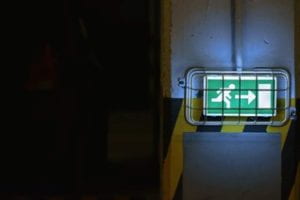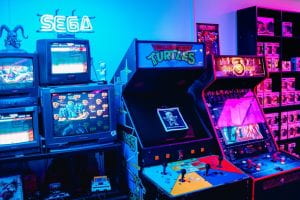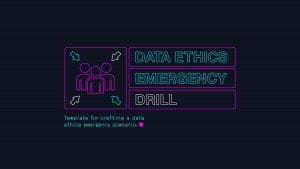This blog post is written by AI CDT student, Vanessa Hanschke
“With regards to AI, this mythologizing and enchantment is apparent when we explore the disjoint between the reality of the technology and its representation.”
…says Beth Singler in her analysis of what she calls the AI Creation Meme – the ubiquitous image of a human hand and a robot hand reaching out to each other with the index finger as in Michelangelo’s infamous painting. Several researchers have commented on the bulk of images used to depict artificial intelligence ranging from inappropriate (e.g. an anthropomorphized robot for natural language processing) to harmful (e.g. the unnecessarily sexist additions of breasts to illustrations of AI in the service industry).
Visual representations of AI matter. In a world where a lot of hype is being generated around AI in industry and policy, I think it is especially important for AI researchers to lead the way in creating better images that are grounded in more accurate conceptualizations of AI. This was one of the many reasons I decided to work with a designer to make visual materials that supported my research in responsible AI.
The Project
A little sidenote description of my research project: the Data Ethics Emergency Drill (DEED) is a method that we created to help industry practitioners of AI, Machine Learning and Data Science reflect on the societal impact and values embedded in their systems. The idea is similar to ethical roleplay. We created fictional scenarios of a data ethics dilemma, which members of a data and AI team discussed in a fake meeting. This fictional scenario is crafted together with some members of the team to address their particular context and AI application. It is presented as an urgent problem that needs fixing within this fake meeting. After trialling this process with two separate industry data science teams, we made a toolbox for other industry teams to pick up and conduct their own drills. This toolbox consists of a PowerPoint slide deck and a Miro board template. We wanted to update these toolbox resources with a professional designer to make them visually engaging and accessible. We collaborated with Derek Edwards, a local designer to Bristol, to create the designs.
The Design Process
Designing is an iterative process and it took some back and forth for the design to come together. Our initial ideas were very vague: we wanted it to be playful as the DEED was about stepping outside of the day-to-day mindset that is focused on technical delivery. We wanted it to be about the human developer responsibility in how we construct our technology today, as opposed to a long-term perspective granting AI human rights. Although “Emergency Drill” is in the title of the toolbox, it is not about hyping AI, but about establishing a safe space to reflect on values embedded in the application.

Emergency Exit Signs served as reference for our designs. Photo by Dids . from Pexels: https://www.pexels.com/photo/emergency-exit-signage-1871343/
The original metaphor that we built this method on was a fire drill. A fire drill goes beyond just looking at the fire exits on a map; it is about experiencing evacuating a building with many people at once. It is about practising collaboration between fire wardens, other security staff and everyone else. Similarly, the DEED goes beyond looking at a list of AI ethics principles, but going through the concrete experience of discussing ethics and values and understanding how responsible AI practises are distributed within a team.

The general look we were going for was inspired by video game arcades. Photo by Stanislav Kondratiev from Pexels : https://www.pexels.com/photo/video-arcade-games-5883539/
Because the outputs were visual, I found it helpful to use images to communicate my personal vision. I set up a folder where I would share material with Derek. Seeing some of Derek’s initial design drafts helped me clarify some of these ideas I had.
The Result
This is the final design of the title slide from the research project *drumroll*:

The final design oft the logo on the slide deck for crafting scenarios.
It is inspired by the sign for assembly point, which is a great metaphor for what the DEED takes from emergency drills: creating an opportunity for an industry team to come together to understand better what is necessary for their responsible AI practise. The colours were inspired by Nineties (capitalise?) arcade video games to add a playful element of technology pop culture.
Working with a designer such as Derek was a very gratifying process and I enjoyed reflecting on what concepts of the DEED toolbox I wanted to transmit visually. The end product of the toolbox resources is a much more an engaging workshop, a more user-friendly slide deck, and a more cohesive visual language of the project overall. I believe it will certainly help with getting more participant teams to engage with my research project.
Recommendations for PhD-Design Collaborations
I would recommend design collaborations to any PhD student carrying out interactive research with visual artefacts. Here are some considerations that might guide your planning:
- What outputs do you need, what formats and how many? Some formats may be more suitable than others, depending on whether you need parts of your design to be editable as your research evolves. An elaborate design may be more striking, but will not always be modifiable (e.g. a hand drawn script logo).
- What is your timeline? The iterative process may take a few weeks, but having that back-and-forth is essential to creating a good design end product.
- What do you want your thing to look like? Collect inspiration on Pinterest and websites that you like. Often online magazines will work with an array of interesting graphic designers. I found a lot of great AI-inspired art in articles of tech magazines.
Thanks
I would like to thank Derek Edwards for the great collaboration and the Interactive AI CDT for funding this part of my research. You can find Derek’s portfolio here. If you are a data scientist, AI or ML engineer thinking about carrying out a Data Ethics Emergency Drill with your team, you can get in touch with me at vanessa.hanschke@bristol.ac.
